
The line between human and AI conversations grows thinner each day. Conversational AI platforms now handle millions of customer interactions with increasingly natural dialogue and understanding. They can adapt, learn, and improve with each customer interaction.
Modern AI platforms transform customer interactions across channels. Sales teams qualify leads faster, support teams handle higher volumes without adding headcount, and customers receive instant, accurate responses at any hour.
This guide cuts through the hype to examine what matters. We’ll explore the top conversational AI platforms for 2025, break down essential features and benefits, and provide a practical framework for choosing the right solution.
Whether you’re looking to automate customer support, enhance sales operations, or streamline workflows, you’ll find actionable insights to guide your decision.
What is a Conversational AI Platform?
Conversational AI platforms represent a quantum leap from their humble beginnings, with ELIZA’s pattern matching in 1966*. Unlike traditional chatbots that follow rigid scripts, these platforms process natural language with a sophisticated understanding of context, sentiment, and intent. They learn from each interaction, building on conversation history to deliver more refined responses.
The foundation rests on three key technologies. Natural Language Processing (NLP) dissects human speech into meaningful data points. Machine Learning algorithms detect patterns and continuously improve responses through exposure to millions of conversations. Speech-to-text conversion enables fluid voice interactions across multiple channels.
Market adoption signals a clear trajectory for conversational AI. Approximately 40% of large organizations already leverage conversational AI in their daily operations*.
The future looks even more connected, with 7 in 10 businesses anticipating AI assistants as standard tools by 2030*. These platforms have evolved beyond simple automation, becoming integral to how businesses understand and serve their customers.
How Conversational AI Works
In practice, conversational AI is a set of technologies that work together. For instance, when a customer calls about an order issue, the system captures their voice, converts it to text, understands the intent, processes the emotion, searches relevant databases, and formulates an appropriate response – all within seconds.
Here’s how it works:
- Think of conversational AI as a skilled interpreter at a global conference. Just as the interpreter processes multiple languages simultaneously, these systems handle countless conversations in real-time, translating human intent into actionable responses.
- Natural Language Processing serves as the system’s ears and brain. When a customer asks about their account balance, NLP breaks down this request into meaningful chunks. It distinguishes between “account” (the subject), “balance” (the specific information needed), and any qualifying details like “savings” or “checking.” This happens in milliseconds, just like a seasoned banker processing a customer’s request.
- Machine Learning and AI models act as the system’s memory and decision-making center. These models train on millions of conversations, learning patterns like a veteran sales representative who’s handled countless calls.
- Last,when a customer expresses frustration about a delayed shipment, the AI recognizes the emotion and adapts its response accordingly, just as an experienced support agent would change their tone.
- Speech technologies complete the communication loop. Speech-to-text converts spoken words into written form with remarkable accuracy, while text-to-speech generates natural-sounding responses. It’s like having a well-trained virtual assistant who can both take perfect notes and speak clearly in any situation.
Conversational AI vs. Chatbots – What’s the Difference?
The gap between traditional chatbots and conversational AI resembles the difference between a vending machine and a knowledgeable store clerk.
While both can provide what you need, their approaches differ dramatically. Traditional chatbots operate like vending machines –input A must match slot B to get result C.
Conversational AI, however, functions more like that experienced clerk who remembers your preferences, understands context, and can handle complex requests. Here’s how they stack up:ir marketing strategies based on real-time emotional trends.
Feature
Traditional Chatbots
Conversational AI
Understanding
Relies on exact keyword matching
Comprehends natural language and context
Learning Ability
Static responses based on predefined rules
Learns and improves from each interaction
Memory
Starts fresh with each interaction
Remembers conversation history and user preferences
Response Generation
Pulls from a fixed library of responses
Generates dynamic responses based on context
Handling Errors
Often breaks when faced with unexpected inputs
Adapts to unclear requests and asks for clarification
Language Processing
Basic word matching
Processes intent, sentiment, and context
Conversation Flow
Linear, script-like interactions
Natural, flexible dialogue
Example Response
“Please choose from: Small/Medium/Large”
“Based on your usual orders, would you prefer…”
Error Recovery
“Sorry, I didn’t understand that”
“Let me clarify – are you asking about…”
Customization
Requires manual updates to rules
Self-improves through machine learning
Try CloudTalk’s AI-powered calling platform free for 14 days.
Top 10 Conversational AI Platforms for 2025
Selecting the right conversational AI platform shapes how your business connects with customers. While big names like ChatGPT grab headlines, specialized business platforms deliver targeted solutions for specific industry needs.
This comparison examines nine leading platforms, breaking down their strengths, limitations, and ideal use cases to help you make an informed choice.
TL;DR
CloudTalk

An AI-powered business calling platform that combines conversation intelligence with comprehensive phone system features. It transforms customer interactions into actionable insights while streamlining sales and support operations.
Key Features:
- Post-call sentiment analysis and conversation monitoring
- Automated call summaries and smart tagging
- Topic extraction and trend identification
- Multi-language transcription and analysis
- CRM integration with automatic data syncing
Pricing:
- Lite: 19
- Starter:34
- Essential: 39
- Expert: 69
Best For:
- Tech companies scaling their sales operations
- Professional service firms handling high call volumes
- Growing SMBs with international customer base
Dialpad
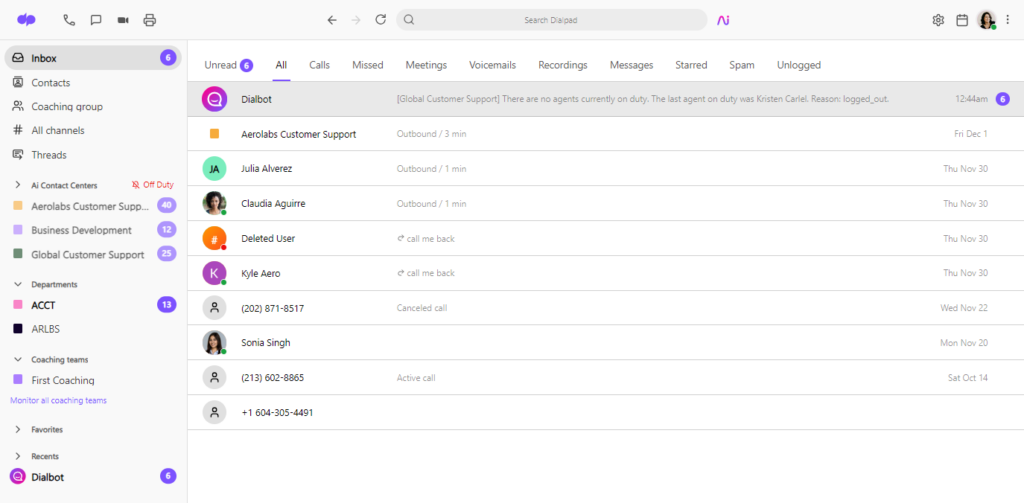
A unified communications platform that leverages AI for voice, video, and messaging. Their conversational AI focuses on real-time assistance and post-call analytics.
Key Features:
- Real-time call transcription and coaching
- AI-powered noise cancellation
- Automated call scoring
- Voice analytics and sentiment tracking
- International calling capabilities
Pricing:
- Standard: $15 user/month
- Pro: $25 per user/month
- Enterprise: Quote-based
Best For:
- Healthcare providers needing HIPAA compliance
- Financial services with remote teams
- Educational institutions requiring distance learning solutions
Sierra AI
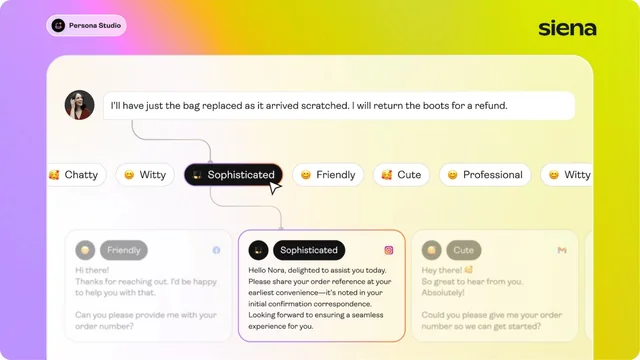
Enterprise-focused conversational AI platform specializing in complex customer service automation and analytics.
Key Features:
- Advanced natural language understanding
- Custom AI model training
- Multi-channel deployment
- Predictive analytics
- Enterprise security compliance
Pricing:
- All plans custom-priced based on usage and features
- Minimum annual contract required
Best For:
- Banking institutions handling sensitive data
- Insurance companies with complex workflows
- Large-scale contact centers
Amelia AI
An enterprise-grade digital AI assistant focused on delivering human-like conversations through deep learning and cognitive automation.
Key Features:
- Emotional intelligence detection
- Process automation integration
- Multi-language natural conversations
- Knowledge management system
- Real-time learning capabilities
Pricing:
- Basic: Custom pricing
- Advanced: Custom pricing
- Enterprise: Custom pricing
Best For:
- Healthcare providers automating patient interactions
- Financial institutions handling complex queries
- Large enterprises with diverse automation needs
Amazon Lex
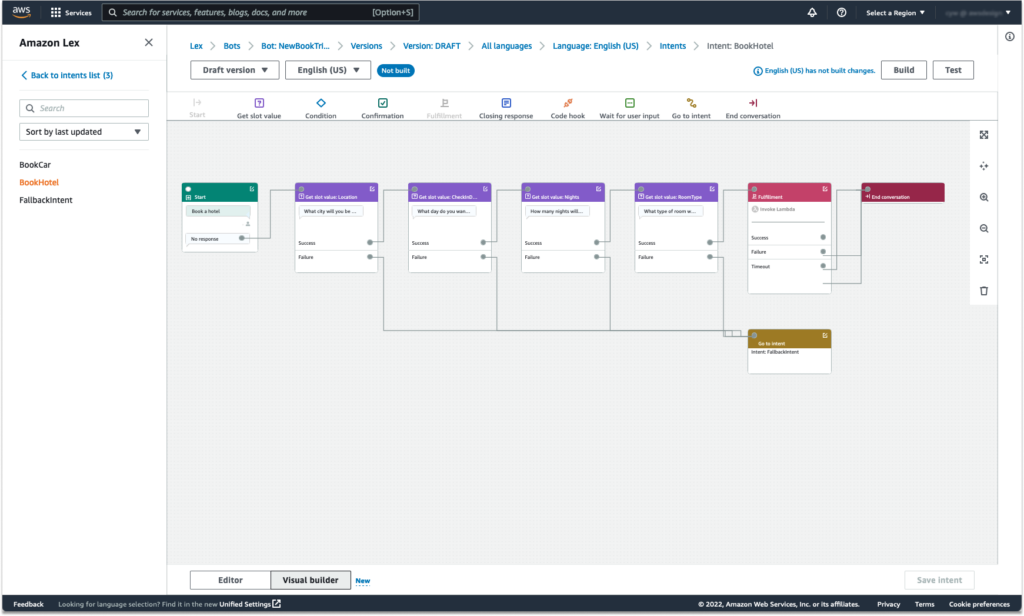
AWS-native conversational AI platform leveraging the same technology that powers Alexa, designed for building conversational interfaces.
Key Features:
- Deep AWS integration
- Speech recognition and synthesis
- Natural language understanding
- Bot lifecycle management
- Multi-platform deployment
Pricing:
- Pay-per-request model
- Text request: $0.00075/request
- Speech request: $0.004/second
Best For:
- E-commerce platforms on AWS
- Tech companies building custom solutions
- Startups needing scalable infrastructure
Yellow.ai
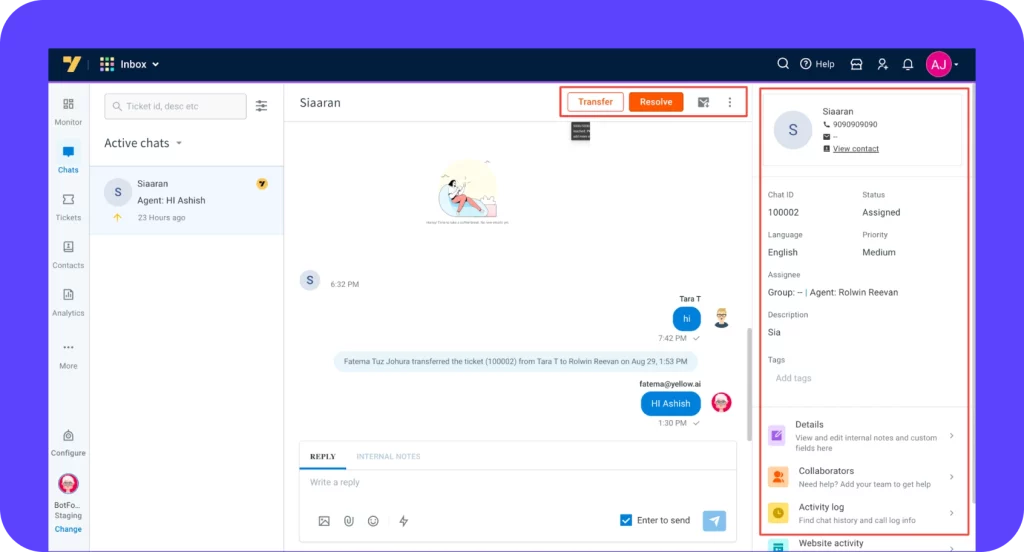
A multi-language conversational AI platform specializing in customer engagement across multiple channels.
Key Features:
- 100+ language support
- Channel-agnostic deployment
- Dynamic conversation flows
- Industry-specific templates
- Advanced analytics suite
Pricing:
- Basic: $100/month
- Enterprise: Custom pricing
Best For:
- Retail chains requiring multi-language support
- eCommerce businesses with global presence
- Companies with diverse customer language needs
Cognigy.ai
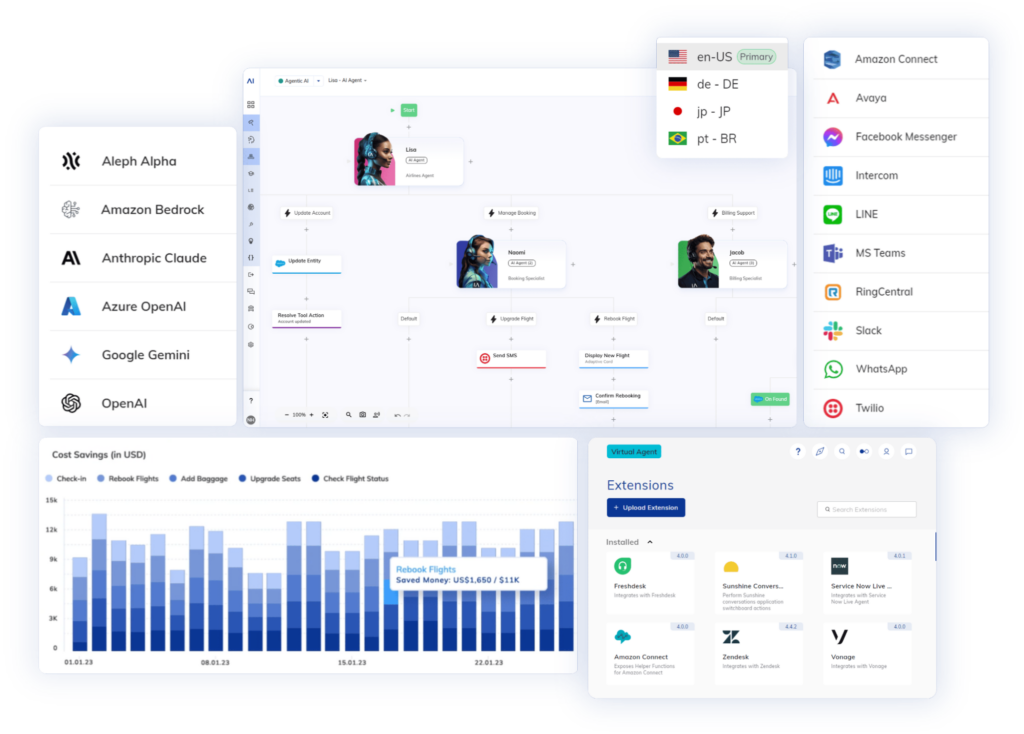
Enterprise conversational AI platform focusing on low-code automation and advanced dialogue management.
Key Features:
- Visual flow builder
- Advanced context management
- Enterprise integrations
- Voice and chat capabilities
- Cognitive search integration
Pricing:
- Standard: Custom pricing
- Professional: Custom pricing
- Enterprise: Custom pricing
Best For:
- Manufacturing companies automating processes
- Retail chains standardizing customer service
- Enterprises needing complex workflow automation
Boost.ai
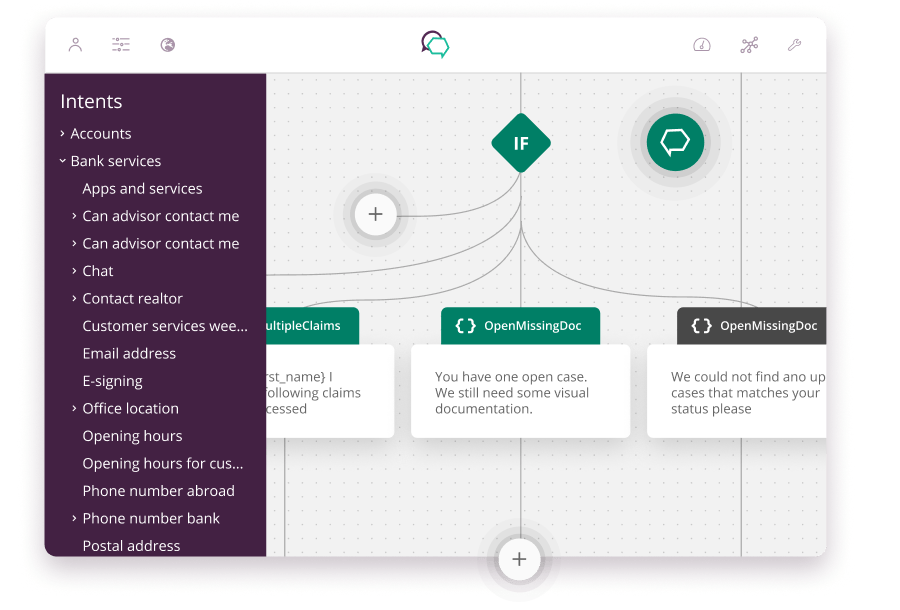
A vertical-focused conversational AI platform specializing in scalable virtual agents for specific industries.
Key Features:
- Industry-specific knowledge bases
- Automated intent recognition
- Multi-language capabilities
- Compliance-ready architecture
- Real-time analytics dashboard
Pricing:
- Quote-based, custom pricing
Best For:
- Banking institutions needing compliant solutions
- Insurance companies automating claims
- Financial services requiring secure communications
Avaamo
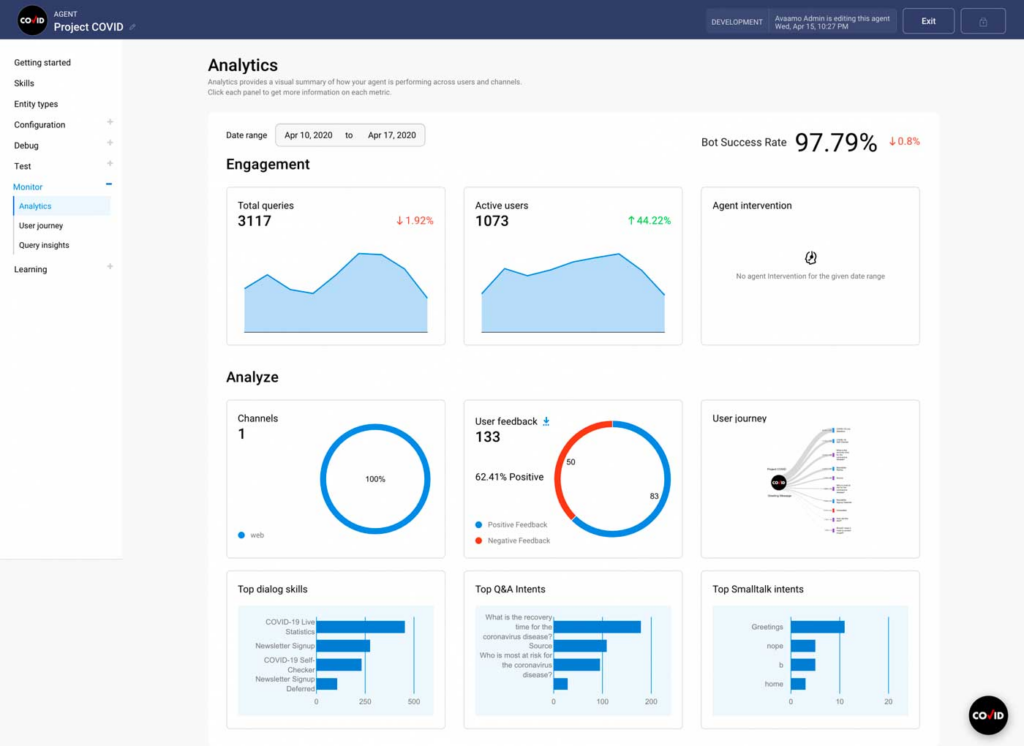
An enterprise-grade conversational AI platform with deep vertical expertise and specialized solutions.
Key Features:
- Vertical-specific conversational flows
- Process automation integration
- Advanced security protocols
- Custom model training
- Multilingual capabilities
Pricing:
- Quote-based, custom pricing
Best For:
- Healthcare providers automating patient engagement
- Manufacturing companies streamlining operations
- Large enterprises needing specialized solutions
Compare conversational AI tools & find the best platform for your business!
Conversational AI Use Cases & Business Benefits
Conversational AI transforms abstract technology into tangible business results. While tech giants showcase chatbots and virtual assistants, mid-sized companies can find practical applications that drive real revenue and efficiency. Here’s how different businesses turned AI capabilities into measurable outcomes.
- Customer Service Automation: Roberta’s company faced a common challenge: endless customer queries and a small support team. After implementing AI-powered support, her team handled triple the volume without adding headcount.
The AI manages routine questions 24/7, while complex issues route to specialists. Her support team now focuses on challenging problems that need human expertise, while customers get instant answers any time of day. - Sales & Lead Qualification: Michael’s B2B sales team of five struggled with lead overflow. His AI assistant now pre-qualifies prospects through smart conversations about budget and timeline. The system learns from each interaction, improving its qualification accuracy over time.
Since implementation, his team’s close rate jumped 40% as they focused exclusively on qualified leads. The AI assistant provides detailed prospect insights before the first human conversation. - HR & Employee Assistance: Jenny’s HR department transformed remote employee support through AI. Her assistant handles everything from vacation requests to benefit inquiries across multiple time zones.
New hires now complete onboarding at their own pace, with the AI providing instant answers about company policies and procedures. The system maintains consistent HR support while Jenny focuses on strategic initiatives and complex employee matters. - eCommerce Support: Lisa’s online furniture store deployed AI to combat cart abandonment and repetitive customer questions. Her AI assistant guides shoppers through product selections, remembers preferences, and provides instant shipping updates.
Cart abandonment dropped 30% as customers received immediate answers to their concerns. The system handles order tracking, inventory checks, and delivery estimates automatically, freeing her team to handle complex customer needs.
Experience how CloudTalk’s conversational AI turns customer calls into actionable insights.
How to Choose the Right Conversational AI Platform
Meet Roberta, an Operations Manager at a growing tech company with 50 employees. Her sales team struggles with manual call logging and missing important conversation details. She needs a conversational AI platform that works, not just another tool that promises the moon.
NLP Accuracy & AI Capabilities
Your AI assistant should understand industry terms and customer intent without constant corrections. Look for platforms that demonstrate accuracy with your specific use cases. Can it detect customer sentiment during sales calls? Does it capture key details without manual input?
Integration Capabilities
Your tech stack matters. The platform should plug seamlessly into your existing CRM and business tools. If your team uses HubSpot or Salesforce, ensure the AI platform can sync call summaries, transcripts, and analytics automatically. No one wants to juggle multiple tabs.
Customization & Training
Every business has unique needs. Your chosen platform should adapt to your processes, not the other way around. Check if you can customize AI models to understand your product terms and sales playbooks. The training process should take days, not months.
Omnichannel Support
Your customers reach out through multiple channels. The platform should handle voice calls, chat, email, and social media with consistent quality. Can it maintain context across channels? Does it provide unified analytics?
Pricing & Scalability
Start with what you need today, but plan for tomorrow. Look for transparent pricing that aligns with your growth. Can you add features as needed? Are there hidden costs for API calls or storage? Make sure the platform grows with your team.
Let’s discuss how conversational AI can boost your team’s performance.
The Future of Business Conversations
The real power of conversational AI lies not in replacing human interaction but in enhancing it. CloudTalk empowers support teams to become strategic advisors and sales representatives to build deeper customer relationships.
AI handles routine tasks while your team focuses on what matters most—building genuine connections and solving complex challenges.
The question isn’t whether to adopt conversational AI, but how to turn conversation data into your competitive advantage. Start transforming your customer interactions today.
Start Optimizing Your Customer Interactions today














